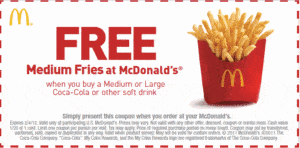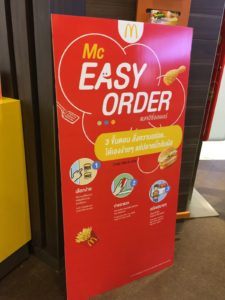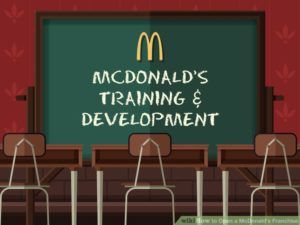From Big Mac to e-Mac: McDonald’s in the digital age

McDonald's is running to grab the last wagon of the digital train and is focusing on innovation in and out of store. The aim is to revamp the stagnant brand and, thus, to increase the number of customers visiting an the average customer spending.
Background
McDonald’s is among the largest and best known brands in the world (ranked as the 7th most powerful brand globally by Forbes and valued at $37.4bn) and the largest chain of fast food restaurants (~69m customers per day, 36,000 restaurants, 119 countries, company website).
Once a groundbreaking innovator and major disruptor of the food industry, McDonald’s used to dominate the fast food chain with its innovative approach on standardization, menu, experience and marketing. Lately however, the brand is getting tired: as consumers quickly shift towards alternative, healthier options, the brand has failed to respond.
First steps
Following the example of various competitors who have been heavily investing in digital, like Starbucks and Subway, and, consequently have increased their client base, McDonald’s decided to start working hard on its Digital Transformation.
To respond to the trend, McDonald’s has focused on improving the food quality and vocally communicating it. However, given that food quality and, most importantly, perception of it is very hard to change, McDonald’s also wants to re-invent the customer experience and move towards the digital age.
And they want to do it fast (“We were late coming to the party, but we will catch up and accelerate.” Don Thompson, Former CEO of McDonald’s) with a strategy is focused on trial and error (“Right now, there’s a high tolerance for risk. The company is seeking progress over perfection […] We can fail fast and spot the successes and scale fast.” Steve Easterbrook, CEO of McDonald’s).
Key initiatives
While the competition looks at how pizza chains let their customers order through mobile, McDonald’s is getting its inspiration from start-ups and big tech companies and wants to work with them.
Firstly, McDonald’s redesigned its mobile application and added new, exciting features to attract customers to their stores. For instance, pilot coupons that would only stay valid for a few minutes were included in the app, e.g. new menu items were advertised and discounted.

Additionally, the company used digital innovation across alternative ordering channels (PC, tablet, mobile phone) to increase revenues. Customers can now order online and quickly their favorite meals. The process is simple. First the customer logs on the application; in the background, geolocation technology is used to identify where he or she is, so as to detect any nearby stores and identify the closest pickup. The menu is clear: new and “preferred items” (based on the customer’s previous orders) are most prominent and the customer simply selects. The payment is conducted online and upon confirmation, the customer receives a code (potentially QR) and can then pick up the prepared meal without waiting. Each restaurant will have a standardized set of the required hardware and software by 2020. The company will use the data collected from customers’ orders to create customized promotions.

But McDonald’s strategy of bringing people to the stores doesn’t stop there. The company focused on adapting new, exiting devices and services within the stores. One of these applications is the smart dinner table. Using NFC (near field communication) and scaletrix design technologies, microchips are placed under the store tables converting them into interactive games, which can be activated using a smartphone screen (within the McDonald’s app). Additionally, following the lead of Starbucks, McDonald’s is piloting wireless charging spots as an additional way to attract customers to hop into their restaurants. Also, McDonald’s was among the first firms to adopt alternative payment systems, like Apple Pay, and introduced it across cashier counters (in store, drive-thru).
Evaluation & next steps
The tactics have stabilized the falling traffic in the store chain, where implemented and evne increased traffic in specific locations.
While McDonald’s realized the threats and opportunities of digital rather late, it is now taking strong action to remain competitive. There are further improvements required to ensure operational efficiency and attract more people to the stores that are not mentioned in the company’s plans.
More precisely, McDonald’s needs to further test the new devices and train personnel on their use, to ensure that the pre-order experience is standardized across the chain, across countries. Maintenance and device replacement is also important and the company needs to frontload these requirements to ensure it delivers what it claims.
Additionally, as more and more people start valuing healthy eating, McDonald’s should leverage technology to explain the exact food ingredients and preparation process, given the improvements happening now. This will help shift the customer perception, bring more traffic to the stores and ensure McDonald’s legacy going forward

Word count: 743
Sources:
http://www.digitaltransformationbook.com/how-McDonald’s-is-preparing-its-digital-transformation/
http://www.forbes.com/pictures/fell45elff/no-7-McDonald’s/#58f7687d65ea
https://www.mcdonalds.com/us/en-us/mcdonalds-app.html
http://thenextweb.com/apps/2016/11/07/mcdonalds-order-pay-online-app/



Thanks for a great post!
One of the tensions I see digitization for McDonald’s is the increasing want to customize orders. For instance, McD’s new in-store “Create Your Taste” screens let’s us make a totally customized burger (http://www4.mcdonalds.ca/createyourtaste/). For a company famous for standardization, I think McDonald’s needs to be very careful in what digitization it adopts to truly understand the impact it has on the operating model (e.g., digital pre-ordering fits with that, but not sure if Create Your Own taste is more of an image driver or actually benefits their operating model).
Nicklas – I like the tension you brought up with the “Create your own taste” touch screens between customization and standardization.
Looks like they’ve already rolled out 500 restaurants with touch screens (http://money.cnn.com/2016/11/17/news/mcdonalds-steve-easterbrook/). Revenue and profits were above forecast since the screens and more customizable options were introduced so it looks like the has been successful thus far. I think that the touch screens will allow will allow McDonald’s to hire less staff and is an investment in a long term play to reduce labor costs.
Well written article!
I was delighted to learn that McDonald’s has a mobile app! I will definitely download it, as I’m a big fan of their meals!
On the digitalization, I believe McDonald’s is pursuing the right path when investing in alternatives ordering channels to increase revenues. Apple Pay is also a smart move as people spend a lot of times in lines, which might hurt the company revenues.
As an ending note, I agree with your suggestion: McDonald’s should definitely leverage technology to better communicate its meals’ ingredients and preparation process. Being more transparent is a must, especially in the food industry.
Thank you for an interesting post!
I was curious to learn what digital innovation initiatives McDonald’s is pursuing. I think that most of the initiatives McDonald’s has implemented seem to be must-haves rather than revolutionary. As their CEO mentioned – they were late to the game. Mobile app, location technology, and coupons are necessary, but not enough. To maintain its position and continue to grow McDonald’s should find a way to deal with the health trend which has intensified in the last few years. Given that its current menu is not at the forefront of healthy food, McDonald’s should use digital to at least offer customers with a way to limit their calorie consumption. For instance, McDonald’s can incorporate an option to customize orders, as Nicklas suggested, but with an added optionality of restricting total calories. Although it would add operational complexity, as standardization will decrease, it will generate new revenue from health-conscious hamburger-loving customers.
Interesting read! It’s clear that a lot of changes are coming to this space. Coupons and in-app ordering are clear benefits that are already becoming pervasive. There’s also the possibility for dynamic offerings, pushing a discount to a user that happens to be near a store that is heavily underutilized, for instance. Additionally, within the store, user-facing POS systems could be implemented which could speed up the ordering process and reduce labor costs.
What I’m wondering on the mobile side is what happens once more restaurants begin to get on board. Is it feasible for the user to have 20 apps installed on their device for different restaurants? Or will we see the emergence of a dominant platform with consolidated offerings – and if so – what form will this take?